How many years before we even start to recognize what the most popular timekeeping devices over the last 70 years were? Another 20 years? Forty?
Who will use timekeepers? And for what purposes? What will they look like?
I posed these questions to top watch industry professionals, including Larry Pettinelli, U.S. president of Patek Philippe, who has some ideas on how to interest younger enthusiasts in a brand that has competed in this market for 178 years and intends on competing in it for the next 178.
Charris Yadigaroglou heads global communications for maverick Swiss independent watchmaker MB&F and he offers a unique insight from a brand that, “ . . . reinterprets traditional, high-quality watchmaking into three-dimensional kinetic sculptures.”
I also queried two watch designers: Emmanuel Gueit of EG Studio, an independent responsible for some watch industry icons including the Rolex Cellini and Audemars Piguet’s Royal Oak Offshore. Octavio Garcia, formerly chief artistic officer at Audemars Piguet, recently launched his own brand Gorilla Watches.
This group of horological visionaries provides extraordinarily insightful and informed opinions on the transition of timekeeping devices across three generations: Millennials, Generation X, and Baby Boomers.
What will a future wristwatch offer that other devices cannot? Let’s find out.
Transitions among the three age groups: Millennials (under 30)
“There will be a new generation of brands going forward,” Gorilla’s Garcia observes. “These will communicate, connect, and interact with a new energy. Ultimately they’ll bridge the generation gap with traditional brands. Millennials will embrace mechanical watches. They’ll be primarily decorative and provide basic timekeeping in a package of 39 to 44 mm, have a mechanical movement, and predominately show the hour, minute and maybe date. Other complications will not be a functional necessity.”
Gueit of EG Studios agrees with this assessment, adding, “The price point will likely be $150 to $300.”

Emmanuel Gueit of EG Studio
As Millennials age, their tastes change. So too does their purchasing capacity.
We’re already seeing watches for this segment of the population transition from an emphasis on function to a preference stressing form – whether that’s the iconic three-handed watch in steel predicted by Gueit and Garcia or the fashion piece that just so happens to tell time.
I see this population segment owning several watches, each of which portrays a different image to combine with other fashion components. There are four major categories of fashion for Millennials: sports, casual, business, and formal. The marketing copy for the watches worn for these activities is all about matching the activity and the outfit.
Nowhere in this copy is the watch’s average time deviation, water resistance, or functionality mentioned. For the Millennials it doesn’t matter. “Functions will become an excuse to show off craftsmanship, status, and taste,” MB&F’s Yadigaroglou predicts. “The future is all about fashion for the Millennials.”

Charris Yadigaroglou, MB&F’s global head of communication
The conclusion here seems to be that Millennials will migrate to elegant simplicity; they will value the fashion statement their watch makes over the time it keeps. Once they’ve decided on their watch (most likely through Internet search), they will buy it online through a site like Amazon or go directly to the manufacturer’s site.
Transitions among the three age groups: Generation X (mid-30s to late 50s)
For Gen Xers, timekeeping devices will transition into something much more focused.
They will want a watch whose brand, functions, and materials are consistent with their personal self-image. Similar to the Millennials, the Xers will likely transition to a watch whose primary purpose is not just timekeeping.
For the Gen Xers, a watch is worn to say as much to others as to the wearer. Whether Xers see themselves as athletic, masters of the business universe, or haute-couture icons, their watches (and the brands that made them) will match that perception.
“As Generation X ages,” says Yadigaroglou, “its watch preference will likely manifest in either of two ways: wearing a mega-brand status symbol watch or moving in the opposite direction and forgetting watch hype. Instead, they might wear a piece that speaks to them on various levels: function, appearance, and brand.”
Rolex is a brand positioned to survive the Gen Xer’s transition into middle age. This upscale marque well known for its quality and design tradition has recently made two moves to capture a greater share of the public’s watch taste.
One of these strategic moves satisfies Gen Xers who want to stick with the Rolex brand image and the statement it makes about sophistication and taste but who may want something less flashy than Rolex’s traditional offerings.
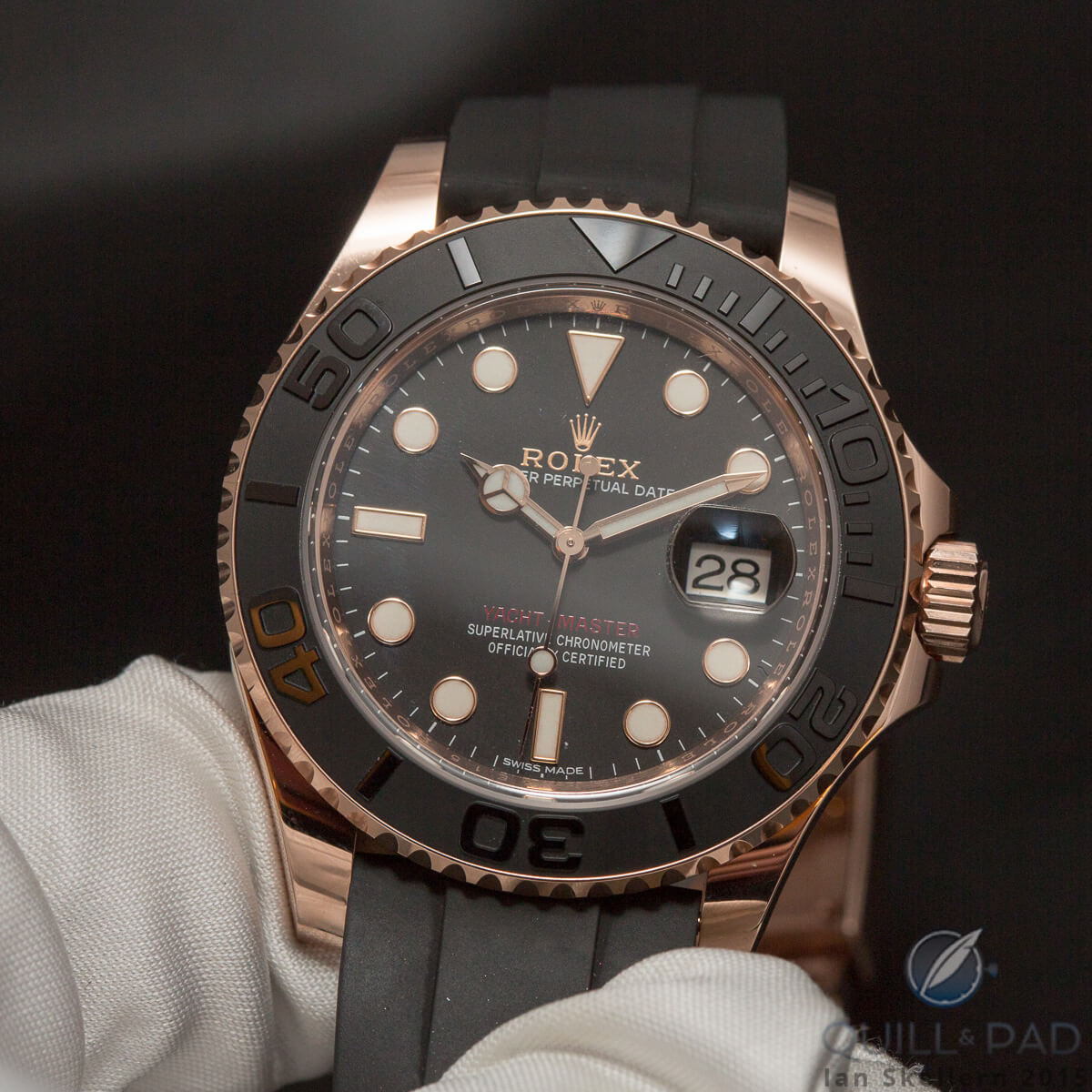
Rolex Oyster Perpetual Yacht-Master 40
One relatively recent example is the Rolex Yacht-Master 40 in Everose gold now available with a rubber Oysterflex bracelet instead of the traditional gold bracelet. This addition to the Rolex line was applauded by many looking for an understated alternative to what others perceive as more the more showy Rolexes – like the Sky-Dweller in Everose gold on a gold bracelet would be (see Spending Time With The Most Complicated In-House Rolex: The Sky-Dweller for more on this watch).
Millennials and Gen Xers both love stainless steel. This hasn’t escaped Rolex’s notice, precipitating the second strategic move on the Genevan giant’s part.
For those making the timekeeping transition into middle age, the venerable brand has introduced what it thinks is one answer. Since its target audience already has a demonstrated appreciation for steel, why not take the most sophisticated Rolex wristwatch and offer it in steel (in addition to precious metals)? Brilliant.
The Gen Xers get to retain the props that the Rolex brand brings to their self-images. At the same time they get a complicated movement encased in the familiar look and feel of stainless steel – all at roughly one-third the price of the precious-metal version.
Middle-aged members of Generation X will likely move away from the emphasis on fashion that their younger Millennial counterparts treasure. “They want to express themselves; show their individuality,” MB&F’s Yadigaroglou says.
Not so fast, counters Patek Philippe’s Pettinelli. “Gen Xers are tied to fashion. Everyone needs a blue blazer or a little black dress. And they will need a watch to go with it. There will always be a place for simple, classic watch designs that will last 100 years.”
Those who appreciate quality and durability seem to be right in Patek Philippe’s sweet spot.
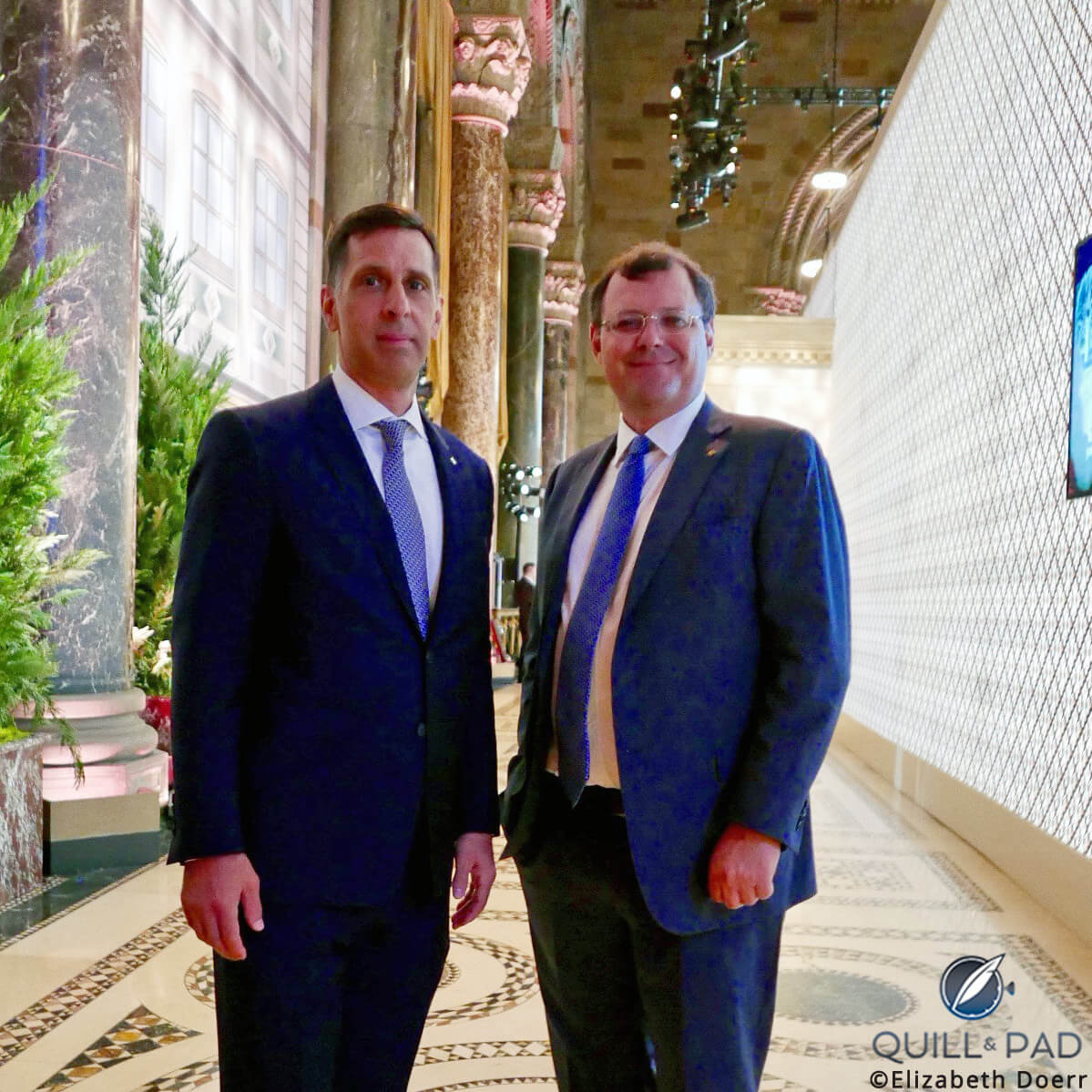
Larry Pettinelli, U.S. president of Patek Philippe (left), with Patek Philippe President Thierry Stern
“Still,” Pettinelli continues, “style and design must be both beautiful and universal enough to be worn all the time and for every occasion. That’s why Patek Philippe emphasizes dial colors and golds that work with many outfits. These pieces serve several social functions at once.”
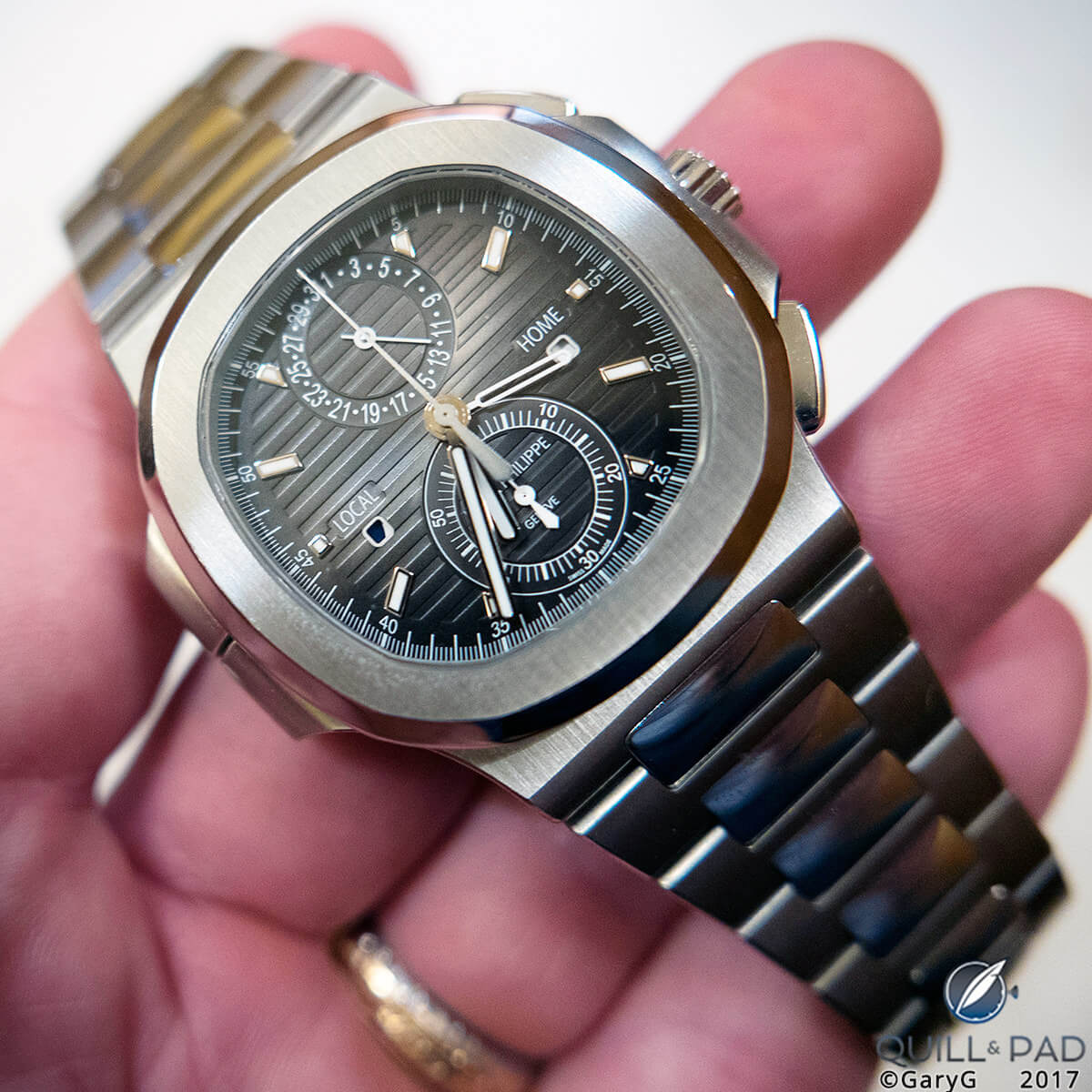
Patek Philippe Reference 5990 Travel Chronograph
For Gen Xers, the watch’s functionality will likely compete against fashion’s prominence. For them a watch must be authentic; it must perform. If it’s a dive watch, it must have the water resistance, durability, and other characteristics of a true dive watch. If it’s a chronograph, then accuracy, pushers, and the characteristic dial set-up are essential.
Functionality also begs the question who will actually use these complications as buyers transition into middle age, and the answer depends on the complications. The sweep second hand of a chronograph is an often-used complication. It’s one so common that many don’t consider it a complication at all, much like the date, which Gen Xers seem to use every day.
Then there are GMT and world timer complications. Once more, we see these as becoming more important to the Gen Xers as their businesses and contacts expand globally. It also confirms what they knew about themselves all along: the world demands a lot of their time and they need to stay on top of it.
Transitions among the three age groups: Baby Boomers (age 60 and above)
For many Baby Boomers a natural migration is a larger dial. If they favored the 40 to 42 mm range when they were younger, it stands to reason that the larger end of that range might attract them as they reach into their 60s.
Gorilla Watches’ Garcia predicts the Baby Boomer’s size preference reaching 48 mm. Additionally, the dial’s legibility becomes as important as the watch functions. Many Boomers see a healthy coat of Super-LumiNova (or equivalent) as a highly desired feature.
Baby Boomers don’t have the time for projecting themselves as something they are not. Having a watch with tiny, impossible-to-read, and never-used complications makes little sense to them.
My opinion is that Boomers will migrate to simpler dials such as three-handed watches, possibly with a date window. Gueit and Garcia’s previously mentioned theory of the timeless, iconic three-hander may indeed evolve full circle from the Millennials to the Boomers.

Octavio Garcia, co-founder of Gorilla Watches
Garcia sees Baby Boomers in three sub-categories: collectors, enthusiasts, and trailblazers. “Collectors will focus more on a particular brand, material and/or function,” he explains. “They want vintage and rare pieces. Enthusiasts look to the iconic brands, and within those brands the iconic models. The trailblazer wants a statement piece. They will focus more on unique designs.”
Involvement seems to be part of the value proposition Baby Boomers look for in a brand. And it turns out that is a strategic feature offered by MB&F. “Our company wants to have direct contact with our customers,” Yadigaroglou says. “In fact, many MB&F customers have a personal relationship with the company; they want to buy from a smaller team where it will have a huge impact. That’s true of many MB&F customers. They become part of our exclusive tribe.”
Smartwatches
Now that Apple is the world’s largest watch manufacturer, we can’t ignore the smartwatch.
“I was once naïve about the Apple watch,” Garcia says. “Maybe even a little jealous. What it has achieved with this third iteration is phenomenal. The new proprietary chip will open new possibilities for the small-format Apple Watch screen. I have come to believe it is destined for a profound impact on the watch trade. However, I’m still not so sure that the smartphone isn’t the most significant competitor of the smartwatch.”
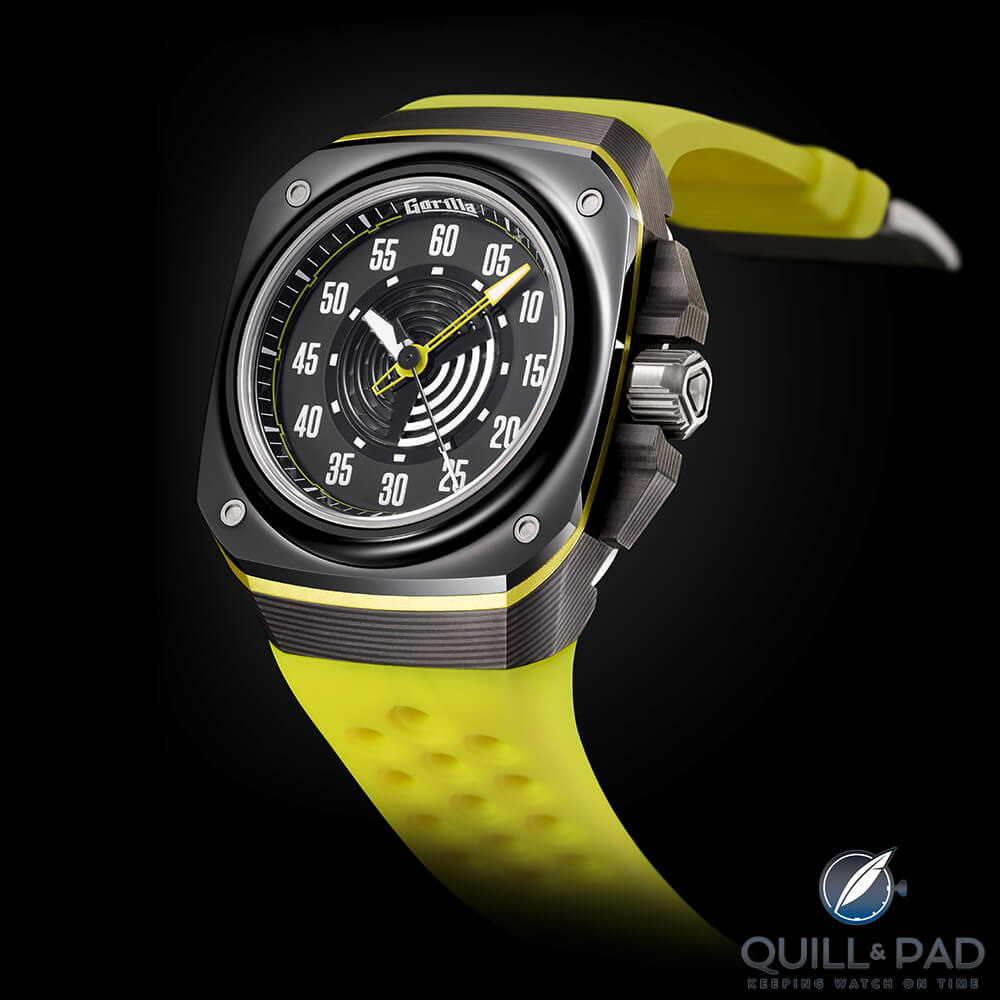
Gorilla Fastback
For many consumers of timekeeping devices it is not a question of owning either a smartwatch or a traditional timepiece. Smartwatches will likely have a place in customers’ collections in the coming decades just as the juxtaposition of a watch and a phone or a sports watch and a dress watch work now.
Smartwatches seem to have crossed the generational chasm – though from what I’ve seen the most prominent smartwatch users will be a melding of Millennials and Gen Xers from their mid-20s all the way to the age of 60.
For these consumers, timekeeping is the least important of their smartwatch’s functions. They use them more for such apps like Calendar, Maps, Fitness, Passbook, Music, Alarm, Stocks, Weather, Photos, Instagram, Twitter, and Uber, to touch just the tip of the app iceberg.
Even so, the traditional three-handed wristwatch will continue to serve a purpose as significant as any smartwatch. My opinion is that neither will be worn so much for timekeeping, though both perform that function very well. The smartwatch is a connected wrist computer and it says something about the wearer’s tech adapter abilities. The traditional mechanical wristwatch says quite a bit about the wearer’s status, respect for tradition, and sense of fashion.
Three stages of watch transition
Of course there are more than three transitional stages that watches are likely to cross during the coming years. I’ve settled on the three that seem most likely: timekeeping, the device transitioning to wearable art, and it transitioning to a keepsake.
1. Timekeeping devices
Not surprisingly, Patek Philippe’s Pettinelli believes that people will continue wearing timekeeping devices regardless of their age. “Certain functions and complications are enduring core values,” he says. “Alarms, travel time options, calendars, and a sweep seconds hand are the most common and useful. These will keep wristwatches in vogue through the coming decades no matter how fashion changes.”
2. Wearable art
Many watch manufacturers have dressed up their traditional watches to become wearable art.
Then there’s MB&F. From the company’s inception, MB&F founder and CEO, Maximilian Büsser (he’s the “MB” in front of the “& Friends” in the company name), intended to create kinetic mechanical sculptures for the wrist. Timekeeping was, and still is, secondary.
The fact is, many MB&F owners don’t even set the time when wearing their watches, and no piece to date even has a second hand. Indeed, demand for MB&F pieces far and away outstrips supply, even though the prices for these pieces begin well into the five and six figures.
According to Yadigaroglou, “That is just the way we like it; the design of a new MB&F project begins with an art idea, not a timekeeping idea. Maybe it’s a spaceship or a car, then the team sets to work. The design is drawn, then the tech team engineers the piece and implements the design. All components are sourced, finished, and then returned to the company for final assembly. That process is why MB&F wearable art pieces are so different than any other watch available.”
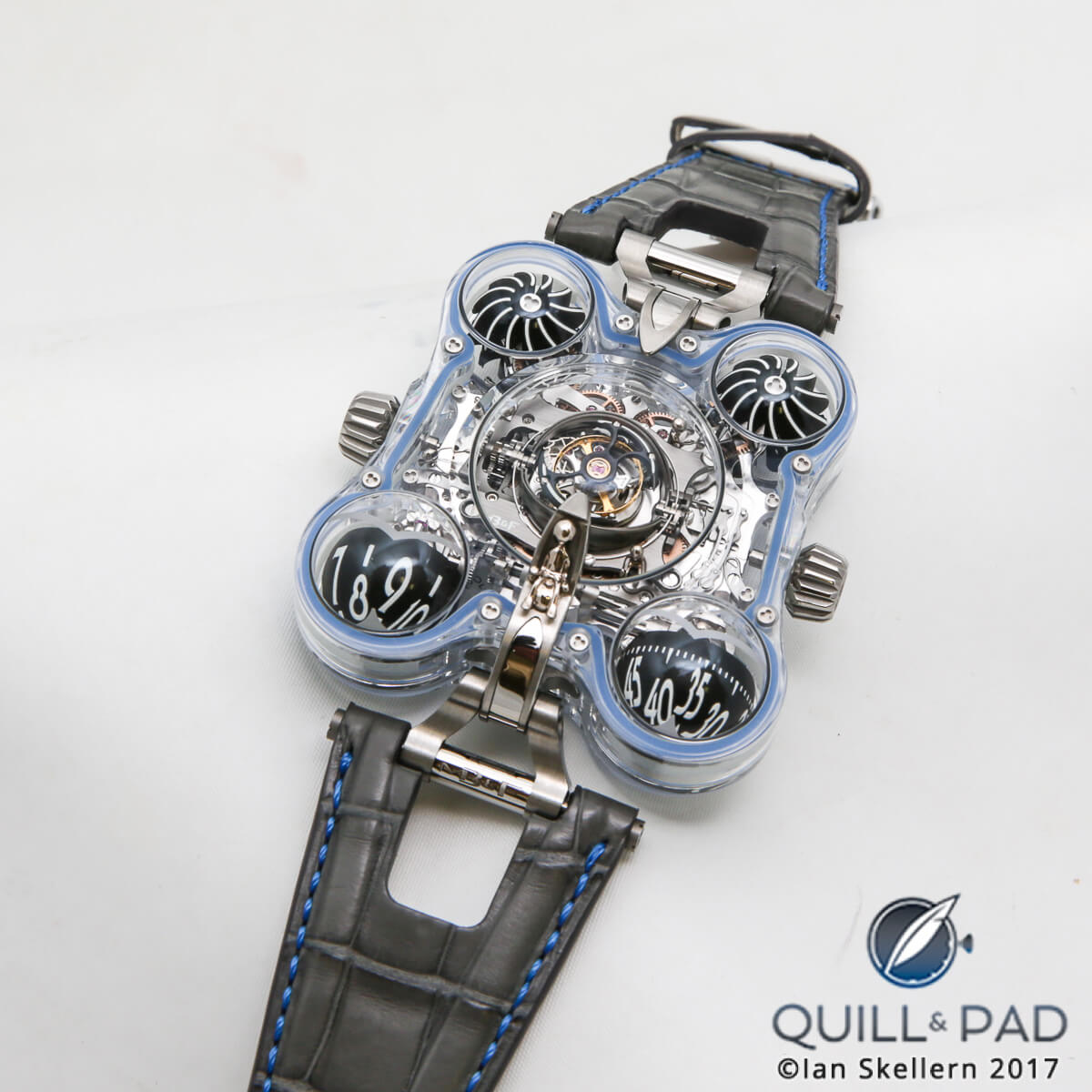
Wearable art: MB&F’s HM6 Alien Nation
For a traditional watch manufacturer such as Patek Philippe, the idea of a timepiece being considered wearable art is less obvious. “But it’s still there,” Pettinelli insists. “Men led the transition to wearable art ahead of women. Just turn over any Patek Philippe with an exhibition back: the beautiful detailed finishing and the depth of the movement is truly wearable art.”
Octavio Garcia sees watches transitioning into a combination of jewelry and mechanical art. “Watches will have a new role as both essential timekeepers with a highly emotional component linked to style. When done well, you cannot separate the function from the emotional/artistic component. It will be both a tool and an artistic expression. Mechanical timepieces will become among the last of the truly emotional product categories.”
3. Keepsakes
The third transition is from wearable art to a keepsake that’s passed to the next generation. Watches are well suited since they’re such a personal possession and have longevity.
Boomers hear that ticking clock of their own mortality; gifting a personal keepsake often scratches that itch. But the watch given must be worthy. Indeed, Patek Philippe has effectively nailed its advertising campaign to aging Baby Boomers with the catch phrase, “You never actually own a Patek Philippe. You merely look after it for the next generation.”
This campaign targets both men and women desiring to leave something of extraordinary meaning, value, and durability behind for the next generation. It places family values front and center, which is not surprising coming as it is from a family-owned business. Often, the Patek Philippe customer’s watch purchases have exactly this future gifting event in mind.
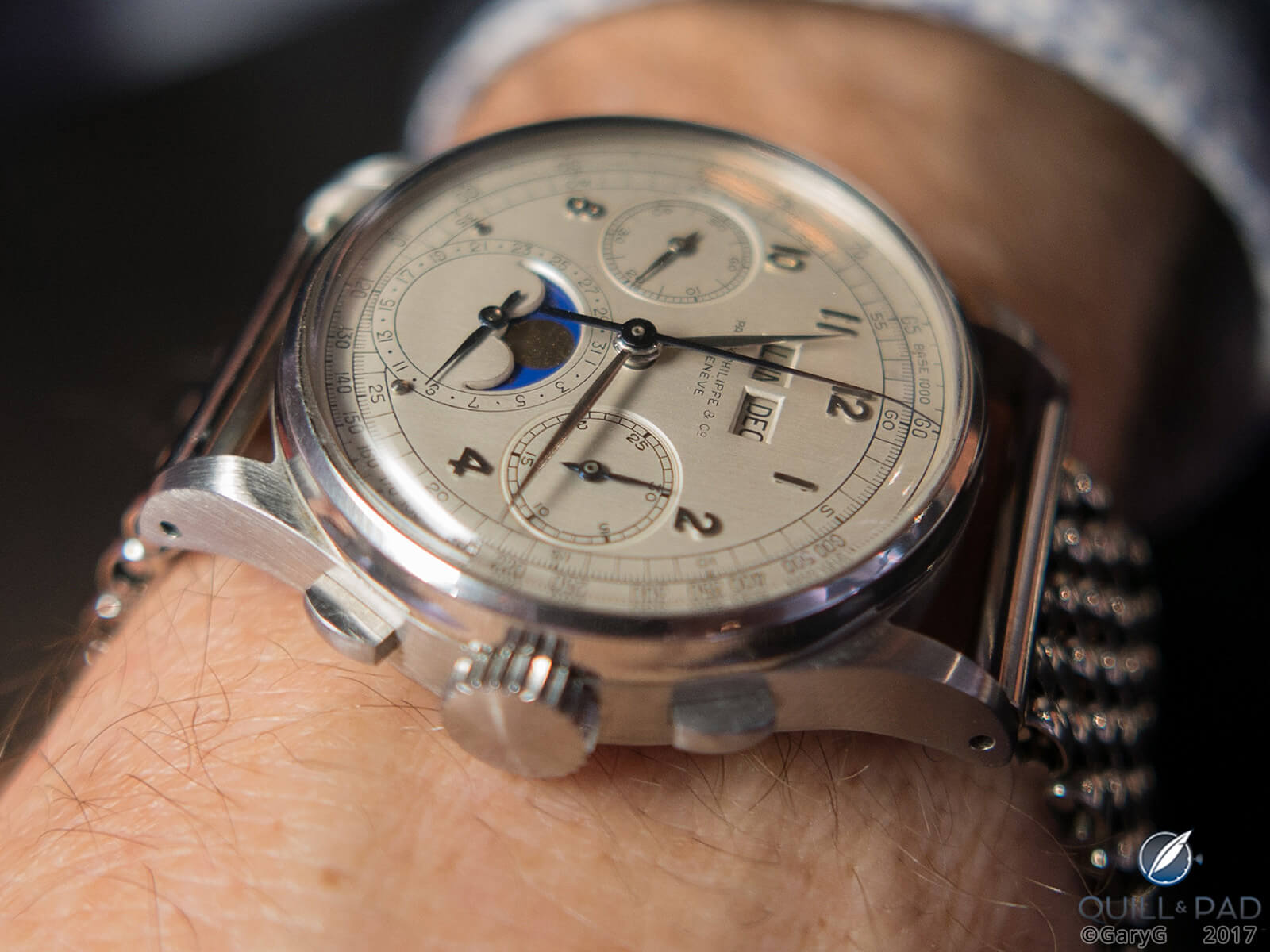
You never actually own a Patek Philippe. You merely look after it for the next generation: here, the Patek Philippe Reference 1518
“Receiving a watch as a keepsake is a notion that I can personally connect with,” Garcia says. “I believe objects carry energy. We feel it when we walk through a historical place or you see an original sketch from an artist’s pencil. Maybe that energy emanates from their worn tools. A timepiece is no different. We buy watches that resonate with us, with our taste, and viewpoint . . . ultimately, an object is made precious by the time spent with it; the moments you experience and stories you can share. That’s what makes it valuable to the next-generation recipient.”
However, there is a drawback to gifting such a wonderful timepiece down one or more generations: unless an appreciation for the value, longevity, and tradition of the watch was taught years earlier, often the gifted piece means far more to the giver than it does to the receiver.
What will a 22-year-old (who relies on a cell phone for timekeeping) do with a vintage watch? It’s not who they are. They’ll toss it in a drawer and forget about it. That five-figure watch will wind down, the oils could dry up, and the case color will tarnish and dull. And the receiver will feel guilty every time he or she opens that drawer and sees the neglected keepsake.
Not the loving memory the grantor had in mind.
Timing devices in 2030
What will timing devices look like in 2030? What functions will they serve? Who will wear them?
Of course the answers are unknowable. Not even the experts consulted for this piece agree among themselves. Yet it seems everyone has an opinion, and there is a final consensus.
Millennials (under 30)
Millennials will likely use some sort of timing device. Many timing devices, in fact, whose primary purpose will probably not be timekeeping, but rather as fashion accessories.
They’ll be unobtrusive – smaller than 40 mm – and light in weight. Electronic functionality will probably enter into the wish list, and Millennials will task these devices with performing a multitude of services. Their cost will be on the low end, probably $500 to $1,000.
Gen Xers (mid-30s to late 50s)
Generation X cares less about the fashion statement a watch makes. Instead, these people will likely gravitate to just a few favorite brands and stick with them, brands that parallel their self-images or project an image that they aspire to. These watches will likely be almost exclusively mechanical rather than electronic. “For women, they’ll likely be automatic rather than manual winding,” Pettinelli predicts.
Unlike the Millennials, Gen Xers will care greatly about their watches’ functionality. They’ll demand certain complications that fit their lifestyle and projected self-image. A good example is the world timer function.
Watches for the middle-aged will be larger than those desired by the Millennials – probably upward of 40 mm. Case materials will begin at steel and work their way up into the precious metals, though some of the interviewees say often stopping short of platinum.
Baby Boomers (60 and above)
The Boomers have made peace with their stations in life. Their watches reflect that they’re comfortable in their own skin. These watches will be less complicated than those belonging to the Xers; think the classic three-hander, maybe with a date window, and likely larger too. “Yet, if we’re talking about wearable art,” MB&F’s Yadigaroglou says, “the piece must be large enough to express the concept. So in some cases we’re talking about some very large pieces.”
Case material is another thing. Boomers can afford the luxurious and the exotic: pink gold, platinum, and perhaps even ceramic won’t be out of the question. Indeed, rarity is what the Boomers want.
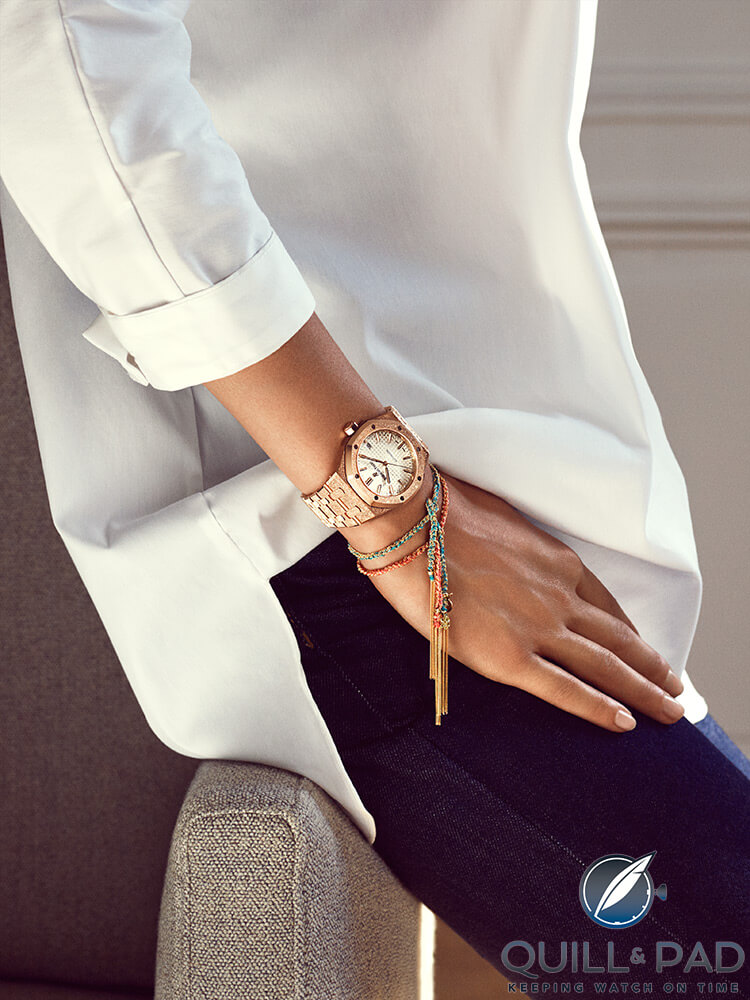
Rarity is what Baby Boomers want: the Audemars Piguet Royal Oak Frosted Gold fits the bill pretty perfectly for a Boomer female
According to the Federation of the Swiss Watch Industry (FH), unit volume of Swiss watch precious metal exports recently were but a fraction of those in steel, yet the value in Swiss francs was almost the same. This parallels the Boomers’ future preference for classic but exclusive brands such as Patek Philippe, Vacheron Constantin, and Audemars Piguet.
Unless Boomers have taken the time to educate their heirs, maybe they won’t gift the progeny their old, but very expensive watches. Instead, perhaps they’ll spend quality time with them while they’re still able to enjoy one another’s company. Let those good times be the memory they leave behind.
I asked Octavio Garcia what else to expect in the migration of timekeeping devices across generations. “Fasten your seat belts,” was his answer.
* This article was first published on October 3, 2017 at What Will The Future Wristwatch Offer Millennials, Generation X, And Baby Boomers That Other Devices Cannot? A Generational Migration Of Timekeeping Examined.
You may also enjoy:
Timekeeping In A 5G World: Coordinated Universal Time Blown Away By Ultra-Precision Time On Tap





















































Leave a Reply
Want to join the discussion?Feel free to contribute!